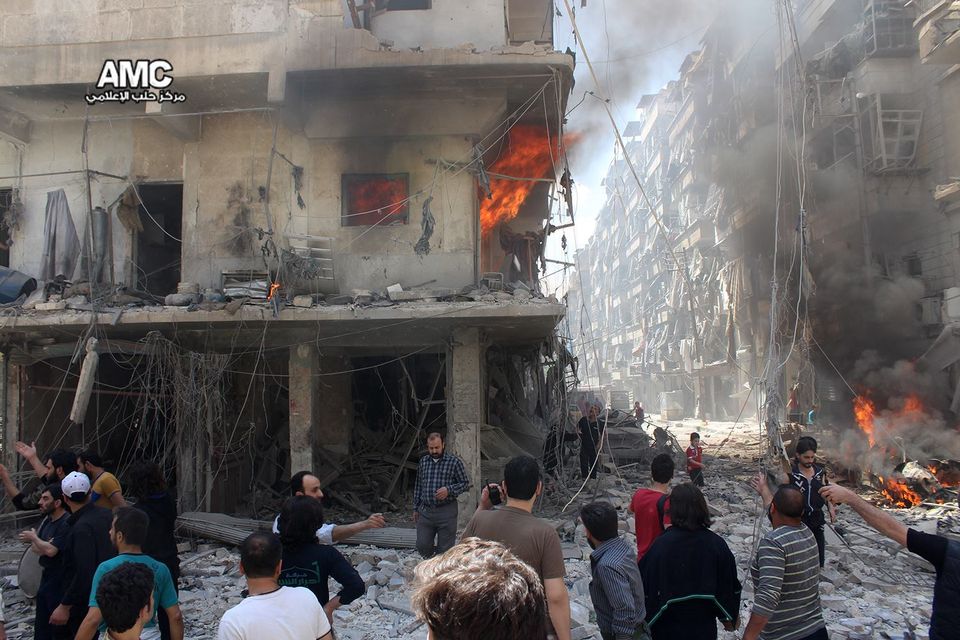
Aleppo's Cessation of Hostilities Meltdown
As violence and civilian deaths surge in the embattled city of Aleppo, it has become increasingly clear that the Cessation of Hostilities (CoH) agreement established on February of this year has completely broken down. Fighting has intensified in Aleppo with over 250 dead in the past two weeks, approximately 50 of whom were killed in an airstrike on Aleppo’s al-Quds hospital. The fighting has left many of the city’s inhabitants in dire need of humanitarian supplies. On Thursday morning, the US and Russia announced a 48-hour ceasefire agreement for the city of Aleppo. However, there have already been reports of violations, including strikes by the Syrian government. As the Syria Justice and Accountability Centre (SJAC) wrote in March, any ceasefire agreement that does not include independent monitoring based on conflict maps to which all parties agree, as well as a system of accountability for those who breach the agreement, will not be effective.
The primary problem with the February CoH centers on Jabhat al-Nusra. In Aleppo in particular, the Assad government has used al-Nusra as a scapegoat to justify airstrikes. Since Jabhat al-Nusra is not party to the CoH, attacks on the group would not be considered violations. Statements by US Secretary of State John Kerry and US Army Col. Steve Warren have supported the Syrian government’s position by implying that al-Nusra’s presence in Aleppo makes it difficult to determine whether violations have occurred. Civilian reports, however, show that the airstrikes have extended beyond the areas under Jabhat al-Nusra’s control and have disproportionately affected civilians.
The disconnect between statements by international leaders and the reality on the ground is causing extreme frustration among Syrians who had a glimmer of hope that the CoH would help return a modicum of normality to their day-to-day lives. Although Jabhat al-Nusra has a presence in Aleppo, the city is subject to a complex configuration of fighting forces, the majority of which are opposition fighters party to the CoH. Airstrikes have been targeting these groups, as well as the civilians within their control, with numerous casualties reported since April 22. These attacks on civilians have gone far beyond what could be justified as collateral damage under international humanitarian law. Moreover, the Syrian government is never justified in targeting hospitals, especially given the lack of evidence that Jabhat al-Nusra has militarily used medical facilities, such as the Medicins Sans Frontieres (MSF) supported hospital that was targeted last week. As for the latest cessation of hostilities agreement for Aleppo, recent breaches reveal the same inherent weaknesses. Moreover, President Bashar al-Assad made statements today that call for “attaining a final victory” against all armed opposition, demonstrating that he is unwilling to make distinctions between al-Nusra and fighting forces party to the CoH and putting into serious question his commitment to the peace process.
SJAC’s March blog post emphasized the importance of conflict mapping and independent monitoring agreed to by all parties in order for any ceasefire agreement to be both effective and durable. The United States has already proposed the idea of creating a detailed map with Russia that would lay out “safe zones” where civilians and members of moderate opposition groups could find shelter from the persistent attacks by the Syrian military and its allies. A clear map of the conflict would clearly show which groups control what areas and would prevent the Assad government from making excuses for its attacks. Independent monitoring is also crucial, as acknowledged by Secretary Kerry in a recent press release which proposed the idea of US and Russian staff working 24/7 in Geneva in order to monitor the CoH. Accountability is also necessary and can be as simple as unified announcements by the UN Security Council to condemn perpetrators. As of now, violations are shrouded in mystery and are easily dismissed by each side as politicized fabrications. An independent monitoring mechanism would shine a light on breaches, and create some form of accountability.
Without the implementation of proper ceasefire monitoring and mapping agreed to by all sides, the CoH will continue to be doomed to failure. A political solution cannot be achieved while the targeting and killing of civilians continue unabated. For this reason, SJAC urges the international community to establish these measures under the umbrella of the CoH as soon as possible. A failure to do so will provide cover for flagrant violations of the agreement, resulting in a further escalation of hostilities and more devastation for the Syrian people.
For more information and to provide feedback, please contact SJAC at [email protected].